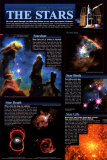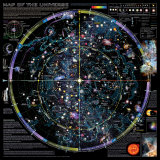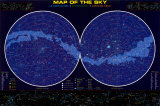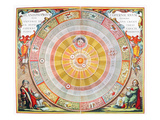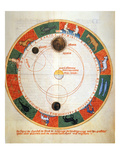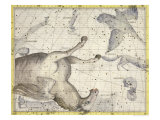|
|
Stars and Star Charts Educational Astronomy Posters
teaching and curriculum resources for the science classroom and home schoolers.
|
science > astronomy > STAR CHARTS < social studies
|
|
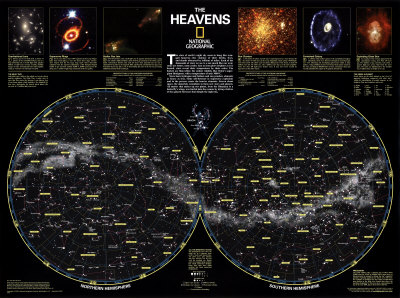
Chart of the Heavens,
Art Print
THE STARS OF EARTH'S NIGHT SKY seem to hang like tranquil lanterns–the violence of their births, lives and deaths obscured by trillions of miles. Each of the thousands of stars we see is a sun much like our own; some ae hotter, some cooler. Just as iron glows brighter as it is heated, stars reveal their temperature by their color: The hottest are blue-white; the coolest reddish, like Orion's super giant Betelgeuse, with a temperature only 3000ºC.
|
|
|
Stars burn hydrogen and helium and can produce elements as heavy as iron. Some self-destruct in supernova explosions and in the process create the heavier element. Strewn about space, the materials recombine to form new stars and planets. All matter that makes up our planet, from the Himalaya to a butterfly's wings, was hurled into the cosmos by dying relatives of the galactic furnaces that dimple the night sky.
ALL THE BRIGHTEST STARS - The hemispheres shw the night sky as it appears from Earth's North and South Poles. All 2,844 stars, plus mebulae and star clusters, can be seen with the unaided eye. Bright stars are assigned large symbols but small numerical designations; dim stars have small symbols but large numerical designations.
PRECESSION - The Earth wobbles, like a spinning top. It takes about 26,000 years for a Pole to realign iwth a given star, yet this precession is enough to changethe star's apparent position, requiring updated star charts every 50 years. For example, on northern sky star charts of 1950 three stars known as the Kids were located just above the meridian designated V. This new chart, representing the sky in the year 2000, places them below that line.
~~~~~~~~~~~~~~~~~~~~~~~~~~~~~~~
Stars are scientifically defined “as self-gravitating spheres of plasma in hydrostatic equilibrium, which generate their own energy through the process of nuclear fusion.” A star emits light because of its intense heat, unlike planets and moons that reflect light. From Earth all stars except the Sun appear to twinkle because of the atmosphere. The Sun, at the center of the Solar System, is classed as a drawf star and appears as a flat disk to Earthlings. It providies both heat and light. Stars typically group in galaxies: the Earth, Solar System and Sun are part of the Milky Way Galaxy. Humans have created mythologies involving the stars and used the stars to navigate the Earth surface.
|
Images include Stonehenge, charts of the Heavens, Celestial Maps and Constellations of the Zodiac.
|
|
|
previous page | top
|
|
I have searched the web for visual, text, and manipulative curriculum support materials - teaching posters, art prints, maps, charts, calendars, books and educational toys featuring famous people, places and events - to help teachers optimize their valuable time and budget.
Browsing the subject areas at NetPosterWorks.com is a learning experience where educators can plan context rich environments while comparing prices, special discounts, framing options and shipping from educational resources.
Thank you for starting your search for inspirational, motivational, and educational posters and learning materials at NetPosterWorks.com. If you need help please contact us.
|
|
|
|















